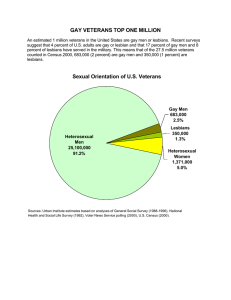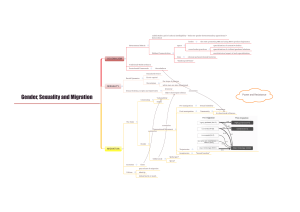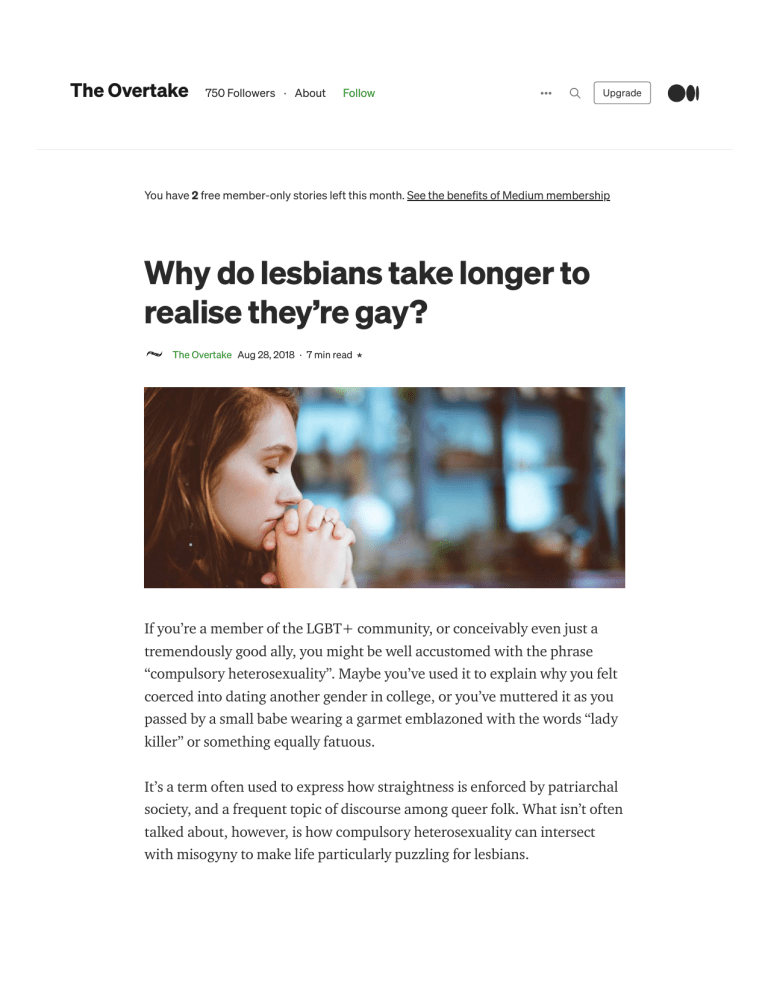
The Overtake 750 Followers · About Follow Upgrade You have 2 free member-only stories left this month. See the benefits of Medium membership Why do lesbians take longer to realise they’re gay? The Overtake Aug 28, 2018 · 7 min read If you’re a member of the LGBT+ community, or conceivably even just a tremendously good ally, you might be well accustomed with the phrase “compulsory heterosexuality”. Maybe you’ve used it to explain why you felt coerced into dating another gender in college, or you’ve muttered it as you passed by a small babe wearing a garmet emblazoned with the words “lady killer” or something equally fatuous. It’s a term often used to express how straightness is enforced by patriarchal society, and a frequent topic of discourse among queer folk. What isn’t often talked about, however, is how compulsory heterosexuality can intersect with misogyny to make life particularly puzzling for lesbians. Although substantial data is hard to come by, the amount of men who knew that they were gay from a young age often seems shockingly higher than that of women. There are even articles and studies that suggest that queer boys commonly experience same-gender attraction for the first time during adolescence or their early teen years, while girls generally don’t until young adulthood — a highly unlikely concept that most lesbians would scoff at. There’s no such thing as being too young to be queer, but there is such a thing as being too young to comprehend compulsory heterosexuality, and it’s harder on gals than it is on guys. Their lives are so entrenched in it, in fact, that little lasses often can’t even recognise when they fancy each other. It’s only when they’re old enough to reason critically that they can reflect on that super-close friendship or really intense admiration for Scully from The X-Files and see what it truly was — infatuation. Compulsory heterosexuality affects women disproportionately to men “I just didn’t recognise my crushes as crushes until, literally, this year,” says Maura*, 33. “I had obsessive thoughts about female coaches and particular celebrities, but I guess I deluded myself into thinking I just wanted to be really close friends with them.” So, what influences lead to women being so disproportionately affected by compulsory heterosexuality? Labour of love Girls are frequently led to believe that dating men is supposed to be difficult for them, and that it’s ordinary to expend emotional and sexual labour without receiving or feeling anything in response because men are so emotionally inadequate or otherwise “masculine”. Muse upon it: TV and film are loaded with heterosexual romances that are largely depicted as a desirable woman putting up with a man — despite it being abundantly evident that he doesn’t make her happy at all — because he has a clandestine heart of gold. There’s the unceasing saga of Penny and Leonard, which appears to have driven her to excessive drinking in late seasons. There’s Tom and Lynette, widely regarded the best couple on Desperate Housewives, despite the former consistently making his wife miserable by contributing the absolute bare minimum to the household and being a lazy father to their brood of six. There’s Supergirl and Mon-El, whose entire relationship seems to hinge on the idea that women exist to make men better people, regardless of the personal cost. It can be difficult for women to distinguish between a wholesale lack of enthusiasm for men and a series of disappointing encounters On top of this, women are socially conditioned to expect and tolerate unsatisfying sexual experiences with men. Almost all TV shows depict sex as being something that occurs until the man climaxes, and then the woman has to deal with not being fulfilled. In real life, studies show that women only orgasm 39% of the time during sex with men, who finish 91% of the time. This can make it impossible for women to distinguish between a wholesale lack of enthusiasm for the male gender and a series of disappointing encounters and relationships — between being gay and being emotionally knackered as a consequence of trying to gratify men — and is one of the most hazardous aspects of compulsory heterosexuality, leading them to attempt to force the attraction long after they’ve realised that there isn’t anything there. I thought I was straight because I was equally unhappy in my relationships with men as most women I knew “I had my first boyfriend when I was 16,” says Andi*, a 33-year-old lesbian who had her first relationship with a woman just last year. “I would complain about him, sexually and emotionally, and my friends would laugh and say it was the same for them. “I thought that hating blowjobs, not being into what guys wanted sexually and feeling like sex was a burden were just normal parts of life. I thought I was straight because I was equally unhappy in my relationships with men as most other women I knew.” Sexualisation The male gaze can be so penetrating at times that women being alluring comes to feel like a matter of course. Women are seldom focused on in the media without being sexualised to some degree, so it can feel like an every day experience when a young gay girl looks at a woman and feels something stirring. “Oh, look, it’s a beautiful woman! Must be a day ending in y!” One can get the impression that the entire world is fixated on female bodies, and adolescent or teen girls may not yet be educated enough to apprehend that corporations such as Rolling Stone, Burger King and even PETA are trying to cater to heterosexual men. Women are depicted as pretty and desirable so any attraction I felt towards women seemed unremarkable This makes it all too easy for women to rationalise their attractions to each other — they may feel no discordance with the surrounding culture, instead believing that everyone has “those kinds” of fantasies about ladies, while gay men might be more able to sense from an early age that their wants aren’t aligned with what mainstream society says they should be. “Women are depicted as pretty and desirable, so any attraction I felt towards women, as a child, seemed unremarkable, for want of a better word,” says Sarah*, 25. This objectification often translates into real life, where women are conventionally expected to perform femininity and expend a lot of effort into being attractive, while their partners are allowed to spend almost little to no effort on their appearance. Men are portrayed as unattractive and something to be dealt with, rather than interested in “People gave me the impression that my own dad was a cut above most in terms of grooming, but when I think about it, that pales in comparison to my mum’s grooming, and she wasn’t even ‘girly’. Being clean-shaven, and having an OK haircut and clothes that actually match is just not as much work as eyebrow plucking, chin waxing and moisturising. “A lot of lesbians think their lack of attraction to men is how all women feel because men are portrayed as unattractive and something to be dealt with, rather than interested in — which is a disservice to both men and women alike.” Sexuality The sociopolitical and cultural suppression of feminine sexuality, especially in youth, may play a considerable role in why it takes girls longer to figure out that they’re gay. Despite being bombarded with images of themselves as sexual objects, women aren’t given permission to indulge desire, meaning that they don’t have the opportunity to become aware of what they find desirable. Ideas about how girls should sit and what they should wear are communicated with the aim of preserving girls’ “innocence” and studies show that negative societal attitudes towards menstruation and breast development often cause parents to restrict girls’ mobility — far more than boys’ — as they sense the potential for early romantic and sexual engagement. Men, on the other hand, are “supposed” to feel sexual desire. While patriarchy imposes control over female sexuality, male sexuality is less of a taboo and young boys are given more opportunity to experiment. I experienced my sexuality in the very early stages of my life and I knew I was gay at about 12 “I experienced my sexuality in the very early stages of my life,” says Navid*, a 20-year-old gay man. “Whenever I saw my friends, it was a topic. We started talking about hot women and nude magazines, but it later evolved into homoerotic interactions and I knew I was gay at about 12. “My best friend is a lesbian and she had that kind of experience with girls, but she didn’t consider that she was gay, and felt guilty enough afterwards not to do it again. She had relationships with men from ages 12–15. Not even attracted to them, she felt the urge to date and be romantic with men, and have a boyfriend. “I couldn’t understand that. See, I too felt the pressure to date women but I never did because I always had that experience with boys.” By Abigail Fenton At The Overtake, we’re trying to bring you stories that you might not see in the mainstream media. If you liked this, please show us some love — every little helps! LGBTQ Lesbian Gay Opinion Journalism About Help Legal
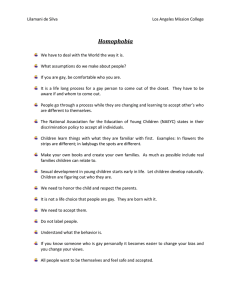
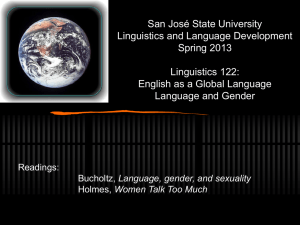
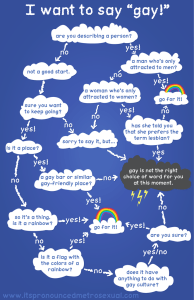
![-----Original Message----- [mailto:] Sent: Tuesday, March 15, 2005 4:00 PM](http://s2.studylib.net/store/data/015587023_1-54e94fc602323868fe7d0334a40d4ded-300x300.png)
